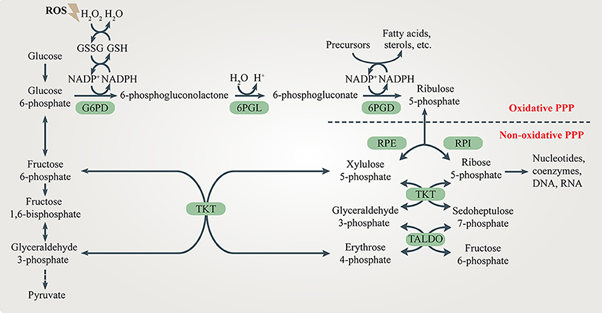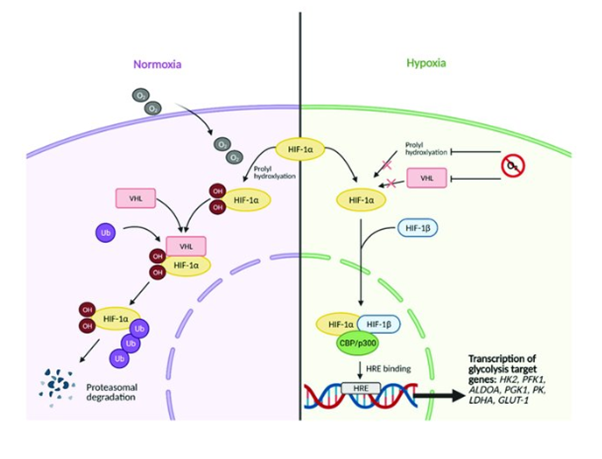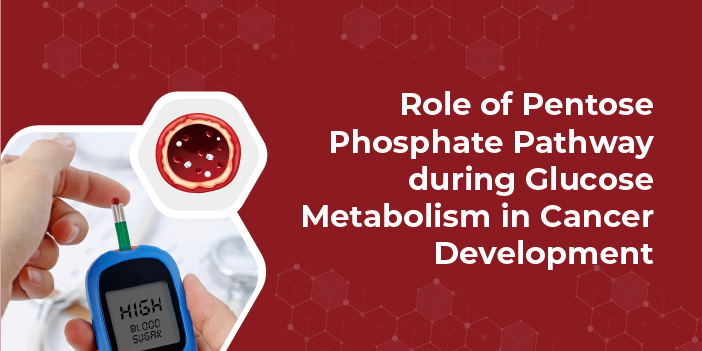Role of Pentose Phosphate Pathway during Glucose Metabolism in Cancer Development
Glucose metabolism in the tumor cells
Cancer cells always have a reprogrammed sugar metabolism that differs from the glucose metabolism occurring in normal body cells because they require a large amount of energy for their survival and uncontrolled proliferation. So, to meet their energy needs, they are always looking for the glucose that they take up from an exogenous environment. These cells produce energy through the process of glycolysis. This process occurs in the cytoplasm of all body cells when there is a deficiency of oxygen. Glucose is converted into pyruvate that later enters the mitochondria and produces ATP energy in the presence of oxygen.
But cancer cells rely mainly on the glycolytic pathway even in presence of the oxygen and this was termed aerobic glycolysis. And this important phenomenon of malignant cells was first proposed by Warburg and the so-called Warburg effect.
Why do cancer cells go for aerobic glycolysis? It occurs because of multiple reasons, the most important being cancer cells require a continuous supply of energy. So, they keep on producing energy by a glycolytic pathway in the cytoplasm, as the transport of pyruvate to the mitochondria and production of energy there takes time, so these cells prefer glycolysis over oxidative phosphorylation. Moreover, this process produces lactic acid which is very crucial for the proliferation of malignant cells and helps them in multiple ways. So, cancer cells metabolize glucose in this way.
The Pentose-Phosphate Pathway (PPP)
This pentose-phosphate pathway PPP is very important in maintaining homeostasis and balance in the cell. It occurs in two major steps producing energy for the cell in the form of NADPH as well as it produces the purines and pyrimidines that are major nitrogenous bases in the cell for the synthesis of nucleic acids such as DNA and RNA, the genetic material in the nucleus of the cell. So, we can say that PPP has multiple major roles in the survival and proliferation of a cell (Cho et al., 2018).
PPP roles in cancer
The PPP or pentose P pathway is not only important in normal body cells but also has many crucial roles in the development as well as progression of cancer. Some of the major roles that are performed by PPP in cancer cells are discussed below.
- The pentose phosphate pathway in the cancer cells produces more and more NADPH, which is a reduced form and has the ability to help the cells escape from programmed cell death or apoptosis.
- It helps the malignant cells to produce more and more energy by providing them with the intermediates of the glycolytic process.
- It is a very crucial pathway for the production of nitrogenous bases such as pyrimidines and purines that are very important for the cell to proliferate as it needs to replicate its genomic material whenever it divides.
- The cancer cells are in need of a larger amount of energy as compared to the normal body cells. They also require lactic acid that helps them in their survival, growth, proliferation, and metastasis. So, PPP also has a crucial role in this regard in malignant cells because it can help the cells to utilize more glucose in the cytoplasm and produce pyruvate by the glycolytic pathway. This pyruvate is then converted to lactic acid by the process of fermentation in the cytosol. So, PPP can help cancer cells in their overall survival.
- It helps the cells during the synthesis of fatty acids, amino acids, as well as nucleic acids. In short, it is a very crucial pathway for the proliferation of malignant cells as it provides them with all the major cellular components (Cossu et al., 2020).

PPP during Glycolysis in Cancer Cells
The pentose-phosphate pathway is very crucial in modulating the metabolism of glucose by the glycolytic pathway in malignant cells. It helps cancer cells to produce enough energy for their survival by meeting their basic energy needs.
As we have talked about earlier, the pentose phosphate pathway produces reduced NADPH. It is produced during the process but when its concentration increases the amount needed by the cell, it will act as a negative feedback inhibitor of the pathway thus inhibiting the G6P dehydrogenase enzyme. And this converts the intermediates of this pathway to enter into the glycolytic pathway and then become part of the glucose metabolism in the cell producing ATP energy that is then used by the cells for multiple purposes such as in signaling pathways for growth and proliferation purposes (Giacomini et al., 2020).
This blockage of the PPP pathway and then the stimulation of the glycolytic pathway in the cancer cells will also accelerate the conversion of pyruvate to lactic acid in these cells. Lactic acid is very crucial for the progression of tumors in that it plays multiple roles in these cells. It helps the cells not only in their growth and proliferation but also in the angiogenesis and metastasis of these cells into the neighboring tissues of the body thus accelerating the progression of tumors throughout the body of an individual. So, PPP has many advantages for cancer cells.
Moreover, if cancer becomes too aggressive and the cells need to proliferate but they become low in nitrogenous bases that are being produced by the PPP pathway in these malignant cells. Then, it has been observed that glucose metabolism that occurs by the glycolytic pathway can play role in the backup for the production of more and more nucleotides so that cells can replicate themselves along with their genetic material.
The important intermediates from the glycolytic pathway, such as glyceraldehyde 6-phosphate and the fructose 6-phosphate, in case of aggressive cancers, enter the PPP pathway for the manufacture of nitrogenous bases. The cells will undergo the non-oxidative phase of this PPP pathway again and again to produce nitrogenous bases that are then converted to nucleic acids and help the cells replicate indefinitely which is an important hallmark of the tumor cells (Patra & Hay, 2014).
So, starting from the uncontrolled proliferation to inhibiting the apoptotic processes in the cancer cells is a very important feature that makes the PPP crucial for the development of malignancy.

Significance of PPP and Glycolysis in cancer cells
The intermediates of both these important pathways involved in cytoplasmic glucose utilization in the cells are the same. So, both pathways can switch into one another in cells. Sometimes, when there is a need for more energy by the cancer cells for performing their basic survival activities, they need to stimulate the glycolytic pathway, and for this purpose, the intermediates of the PPP pathway are moved into the glycolytic process and the ATP energy production is increased due to increased glucose metabolism that is taken from the outside of the cell and utilized in cell cytoplasm for energy production (Jiang et al., 2014).
However, on the other hand, the cancer cells also need to proliferate indefinitely for their progression and metastasis into other body cells and tissues. And for this purpose, they need more nucleic acids to replicate their genetic material. The first phase of the PPP pathway is crucial for the production of nitrogenous bases in the form of A, G,T, and C. Then, the intermediates of the glycolytic pathway move into the PPP pathway, and the production of nucleotides in the malignant cells is stimulated. These cells will then proliferate and the tumor progresses.
How do intermediates of one pathway become part of the second pathway? Does enzymes of the new pathway work on these intermediates? Yes, this occurs because in both the cases, PPP and the glycolytic pathway, the enzymes of the pathway need alkaline pH to perform their optimum activity. So, the pH in both pathways is the same and the intermediates can switch between both of these pathways depending upon the need of the malignant cells (Alfarouk et al., 2020).

Conclusion
The PPP pathway is very crucial for the cells of the body of an individual in that it provides energy as well as provides the nucleotides required for the replication and division of a cell. It is an important pathway for the utilization of glucose just like the glycolytic pathway and occurs in the cytoplasm of a cell. Moreover, the intermediates of both the glycolytic and PPP are mutual and can switch between the pathways.
This pathway helps the malignant cells in multiple ways, not only helping them in their survival and progression or metastasis but also providing them an advantage of escaping apoptosis by modifying the process in mitochondria.
References
Alfarouk, K. O., Ahmed, S. B. M., Elliott, R. L., Benoit, A., Alqahtani, S. S., Ibrahim, M. E., Bashir, A. H. H., Alhoufie, S. T. S., Elhassan, G. O., Wales, C. C., Schwartz, L. H., Ali, H. S., Ahmed, A., Forde, P. F., Devesa, J., Cardone, R. A., Fais, S., Harguindey, S., & Reshkin, S. J. (2020). The pentose phosphate pathway dynamics in cancer and its dependency on intracellular pH. Metabolites, 10(7), 1–16. https://doi.org/10.3390/metabo10070285
Cho, E. S., Cha, Y. H., Kim, H. S., Kim, N. H., & Yook, J. I. (2018). The pentose phosphate pathway as a potential target for cancer therapy. Biomolecules and Therapeutics, 26(1), 29–38. https://doi.org/10.4062/biomolther.2017.179
Cossu, V., Bonanomi, M., Bauckneht, M., Ravera, S., Righi, N., Miceli, A., Morbelli, S., Orengo, A. M., Piccioli, P., Bruno, S., Gaglio, D., Sambuceti, G., & Marini, C. (2020). Two high-rate pentose-phosphate pathways in cancer cells. Scientific Reports, 10(1), 1–9. https://doi.org/10.1038/s41598-020-79185-2
Giacomini, I., Ragazzi, E., Pasut, G., & Montopoli, M. (2020). The pentose phosphate pathway and its involvement in cisplatin resistance. International Journal of Molecular Sciences, 21(3). https://doi.org/10.3390/ijms21030937
Jiang, P., Du, W., & Wu, M. (2014). Regulation of the pentose phosphate pathway in cancer. Protein and Cell, 5(8), 592–602. https://doi.org/10.1007/s13238-014-0082-8
Patra, K. C., & Hay, N. (2014). The pentose phosphate pathway and cancer. Trends in Biochemical Sciences, 39(8), 347–354. https://doi.org/10.1016/j.tibs.2014.06.005
